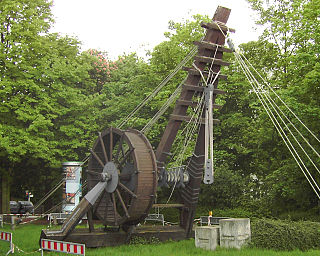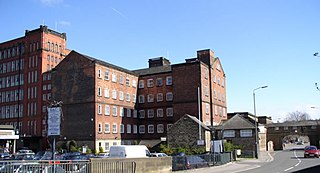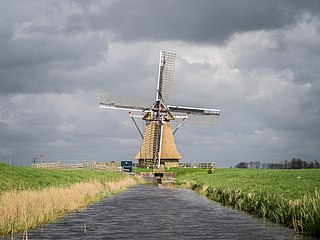Related Research Articles

A watermill or water mill is a mill that uses hydropower. It is a structure that uses a water wheel or water turbine to drive a mechanical process such as milling (grinding), rolling, or hammering. Such processes are needed in the production of many material goods, including flour, lumber, paper, textiles, and many metal products. These watermills may comprise gristmills, sawmills, paper mills, textile mills, hammermills, trip hammering mills, rolling mills, wire drawing mills.

A water wheel is a machine for converting the energy of flowing or falling water into useful forms of power, often in a watermill. A water wheel consists of a wheel, with a number of blades or buckets arranged on the outside rim forming the driving car.

Quarry Bank Mill in Styal, Cheshire, England, is one of the best preserved textile factories of the Industrial Revolution. Built in 1784, the cotton mill is recorded in the National Heritage List for England as a designated Grade II* listed building. Quarry Bank Mill was established by Samuel Greg, and was notable for innovations both in machinery and also in its approach to labour relations, the latter largely as a result of the work of Greg's wife, Hannah Lightbody. The family took a somewhat paternalistic attitude toward the workers, providing medical care for all and limited education to the children, but all laboured roughly 72 hours per week until 1847 when a new law shortened the hours.

Claverton Pumping Station in the village of Claverton, in the English county of Somerset, pumps water from the River Avon to the Kennet and Avon Canal using power from the flow of the River Avon. It is a Grade I listed building, having been upgraded from Grade II in 2019.

Matthew Murray was an English steam engine and machine tool manufacturer, who designed and built the first commercially viable steam locomotive, the twin cylinder Salamanca in 1812. He was an innovative designer in many fields, including steam engines, machine tools and machinery for the textile industry.

The ancient Romans were famous for their advanced engineering accomplishments. Technology for bringing running water into cities was developed in the east, but transformed by the Romans into a technology inconceivable in Greece. The architecture used in Rome was strongly influenced by Greek and Etruscan sources.
B. Hick and Sons, subsequently Hick, Hargreaves & Co, was a British engineering company based at the Soho Ironworks in Bolton, England. Benjamin Hick, a partner in Rothwell, Hick and Rothwell, later Rothwell, Hick & Co., set up the company in partnership with two of his sons, John (1815–1894) and Benjamin (1818–1845) in 1833.

Belper North Mill, also known as Strutt's North Mill in Belper, is one of the Derwent Valley Mills, given UNESCO World Heritage Status in 2001.

George Sorocold was an engineer in Derby, England, in the eighteenth century.

The Leeds Industrial Museum at Armley Mills is a museum of industrial heritage located in Armley, near Leeds, in West Yorkshire, Northern England. The museum includes collections of textile machinery, railway equipment and heavy engineering amongst others.
Frequently used in mines and probably elsewhere, the reverse overshot water wheel was a Roman innovation to help remove water from the lowest levels of underground workings. It is described by Vitruvius in his work De architectura published circa 25 BC. The remains of such systems found in Roman mines by later mining operations show that they were used in sequences so as to lift water a considerable height.

John Wallis Titt (1841–1910) was a late nineteenth-century English mechanical engineer and builder of a particular design of large wind engine.

Little Matlock Rolling Mill also known as Low Matlock Rolling Mill is a Grade II* Listed building situated on the River Loxley in the village of Loxley on the outskirts of the City of Sheffield, South Yorkshire, England. The building continues to operate as a rolling mill, owned and operated by Pro-Roll Ltd, a specialist hand rolling company. A brick building extension was added to the original 1882 structure in 1939.

Deeping Fen is a low-lying area in the South Holland district of Lincolnshire, England, which covers approximately 47 square miles (120 km2). It is bounded by the River Welland and the River Glen, and is extensively drained, but the efficient drainage of the land exercised the minds of several of the great civil engineers of the 17th and 18th centuries.

Cocking Foundry is an abandoned iron foundry in the South Downs of England. It was situated to the north of the village of Cocking, West Sussex and was active for most of the 19th century. The foundry's output included wheels for watermills, some of which remain in use.
Thomas Yeoman was a millwright, surveyor and civil engineer who played a significant part in the early industrial revolution and became the first president of the first engineering society in the world, the Society of Civil Engineers, now known as the Smeatonian Society of Civil Engineers.

Coultershaw Bridge is a rural community situated 1.5 mi (2.4 km) south of the town Petworth in West Sussex, England where the A285 road from Petworth to Chichester crosses the River Rother.

't Zwaantje is a smock mill in Nijemirdum, Friesland, Netherlands which was built in 1878. The mill has been restored to working order. It is listed as a Rijksmonument.

De Klaarkampstermeermolen is a smock mill in Rinsumageast, Friesland, Netherlands which was built in 1893. The mill has been restored to working order. It is listed as a Rijksmonument.

De Hoop is a smock mill in Readtsjerk, Friesland, Netherlands which was built in 1911. The mill has been restored to working order. It is listed as a Rijksmonument.
References
- Notes
- ↑ Chrimes 2002, p. 322.
- Bibliography
Chrimes, Mike (2002). "Thomas Hewes". In Institute of Civil Engineers (ed.). A Biographical Dictionary of Civil Engineers in Great Britain and Ireland. 1. Thomas Telford Publishing. ISBN 0-7277-2939-X.